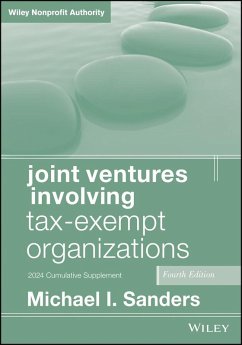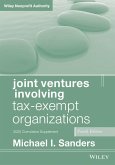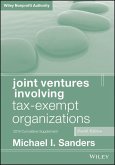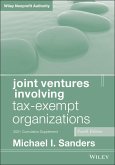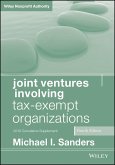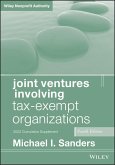Michael I. Sanders
Joint Ventures Involving Tax-Exempt Organizations, 2024 Cumulative Supplement (eBook, PDF)
125,99 €
125,99 €
inkl. MwSt.
Sofort per Download lieferbar

0 °P sammeln
125,99 €
Als Download kaufen

125,99 €
inkl. MwSt.
Sofort per Download lieferbar

0 °P sammeln
Jetzt verschenken
Alle Infos zum eBook verschenken
125,99 €
inkl. MwSt.
Sofort per Download lieferbar
Alle Infos zum eBook verschenken

0 °P sammeln
Michael I. Sanders
Joint Ventures Involving Tax-Exempt Organizations, 2024 Cumulative Supplement (eBook, PDF)
- Format: PDF
- Merkliste
- Auf die Merkliste
- Bewerten Bewerten
- Teilen
- Produkt teilen
- Produkterinnerung
- Produkterinnerung

Bitte loggen Sie sich zunächst in Ihr Kundenkonto ein oder registrieren Sie sich bei
bücher.de, um das eBook-Abo tolino select nutzen zu können.
Hier können Sie sich einloggen
Hier können Sie sich einloggen
Sie sind bereits eingeloggt. Klicken Sie auf 2. tolino select Abo, um fortzufahren.

Bitte loggen Sie sich zunächst in Ihr Kundenkonto ein oder registrieren Sie sich bei bücher.de, um das eBook-Abo tolino select nutzen zu können.
A comprehensive, revised, and expanded guide covering tax-exempt organizations engaging in joint ventures
Joint Ventures Involving Tax-Exempt Organizations, Fourth Edition examines the liability of, and consequences to, exempt organizations participating in joint ventures with for-profit and other tax-exempt entities. This authoritative guide provides unbridled access to relevant IRC provisions, Treasury regulations, IRS rulings, and pertinent judicial decisions and legislative developments that impact exempt organizations involved in joint ventures.
Features in depth analysis of the…mehr
- Geräte: PC
- mit Kopierschutz
- eBook Hilfe
- Größe: 2.16MB
Andere Kunden interessierten sich auch für
![Joint Ventures Involving Tax-Exempt Organizations, 2023 Cumulative Supplement (eBook, PDF) Joint Ventures Involving Tax-Exempt Organizations, 2023 Cumulative Supplement (eBook, PDF)]() Michael I. SandersJoint Ventures Involving Tax-Exempt Organizations, 2023 Cumulative Supplement (eBook, PDF)125,99 €
Michael I. SandersJoint Ventures Involving Tax-Exempt Organizations, 2023 Cumulative Supplement (eBook, PDF)125,99 €![Joint Ventures Involving Tax-Exempt Organizations, 2020 Cumulative Supplement (eBook, PDF) Joint Ventures Involving Tax-Exempt Organizations, 2020 Cumulative Supplement (eBook, PDF)]() Michael I. SandersJoint Ventures Involving Tax-Exempt Organizations, 2020 Cumulative Supplement (eBook, PDF)115,99 €
Michael I. SandersJoint Ventures Involving Tax-Exempt Organizations, 2020 Cumulative Supplement (eBook, PDF)115,99 €![Joint Ventures Involving Tax-Exempt Organizations, 2018 Cumulative Supplement (eBook, PDF) Joint Ventures Involving Tax-Exempt Organizations, 2018 Cumulative Supplement (eBook, PDF)]() Michael I. SandersJoint Ventures Involving Tax-Exempt Organizations, 2018 Cumulative Supplement (eBook, PDF)115,99 €
Michael I. SandersJoint Ventures Involving Tax-Exempt Organizations, 2018 Cumulative Supplement (eBook, PDF)115,99 €![Joint Ventures Involving Tax-Exempt Organizations, 2021 Cumulative Supplement (eBook, PDF) Joint Ventures Involving Tax-Exempt Organizations, 2021 Cumulative Supplement (eBook, PDF)]() Michael I. SandersJoint Ventures Involving Tax-Exempt Organizations, 2021 Cumulative Supplement (eBook, PDF)115,99 €
Michael I. SandersJoint Ventures Involving Tax-Exempt Organizations, 2021 Cumulative Supplement (eBook, PDF)115,99 €![Joint Ventures Involving Tax-Exempt Organizations, 2019 Cumulative Supplement (eBook, PDF) Joint Ventures Involving Tax-Exempt Organizations, 2019 Cumulative Supplement (eBook, PDF)]() Michael I. SandersJoint Ventures Involving Tax-Exempt Organizations, 2019 Cumulative Supplement (eBook, PDF)115,99 €
Michael I. SandersJoint Ventures Involving Tax-Exempt Organizations, 2019 Cumulative Supplement (eBook, PDF)115,99 €![Joint Ventures Involving Tax-Exempt Organizations, 2022 Cumulative Supplement (eBook, PDF) Joint Ventures Involving Tax-Exempt Organizations, 2022 Cumulative Supplement (eBook, PDF)]() Michael I. SandersJoint Ventures Involving Tax-Exempt Organizations, 2022 Cumulative Supplement (eBook, PDF)115,99 €
Michael I. SandersJoint Ventures Involving Tax-Exempt Organizations, 2022 Cumulative Supplement (eBook, PDF)115,99 €![Joint Ventures Involving Tax-Exempt Organizations, 2024 Cumulative Supplement (eBook, ePUB) Joint Ventures Involving Tax-Exempt Organizations, 2024 Cumulative Supplement (eBook, ePUB)]() Michael I. SandersJoint Ventures Involving Tax-Exempt Organizations, 2024 Cumulative Supplement (eBook, ePUB)125,99 €
Michael I. SandersJoint Ventures Involving Tax-Exempt Organizations, 2024 Cumulative Supplement (eBook, ePUB)125,99 €-
-
-
A comprehensive, revised, and expanded guide covering tax-exempt organizations engaging in joint ventures
Joint Ventures Involving Tax-Exempt Organizations, Fourth Edition examines the liability of, and consequences to, exempt organizations participating in joint ventures with for-profit and other tax-exempt entities. This authoritative guide provides unbridled access to relevant IRC provisions, Treasury regulations, IRS rulings, and pertinent judicial decisions and legislative developments that impact exempt organizations involved in joint ventures.
Written by a noted expert in the field, Joint Ventures Involving Tax-Exempt Organizations, Fourth Edition is the most in-depth discussion of this critical topic.
Joint Ventures Involving Tax-Exempt Organizations, Fourth Edition examines the liability of, and consequences to, exempt organizations participating in joint ventures with for-profit and other tax-exempt entities. This authoritative guide provides unbridled access to relevant IRC provisions, Treasury regulations, IRS rulings, and pertinent judicial decisions and legislative developments that impact exempt organizations involved in joint ventures.
- Features in depth analysis of the IRS's requirements for structuring joint ventures to protect a nonprofit's exemption as well as to minimize UBIT
- Includes sample models, checklists, and numerous citations to Internal Revenue Code sections, Treasury Regulations, case law, and IRS rulings
- Presents models, guidelines, and suggestions for structuring joint ventures and minimizing the risk of audit
- Contains detailed coverage of: new Internal Revenue Code requirements impacting charitable hospitals including Section 501(r) and related provisions; university ventures, revised Form 990, with a focus on nonprofits engaged in joint ventures; the IRS's emphasis on good governance practices; international activities by nonprofits; and a comprehensive examination of the New Market Tax Credits and Low Income Housing Tax Credits arena
Written by a noted expert in the field, Joint Ventures Involving Tax-Exempt Organizations, Fourth Edition is the most in-depth discussion of this critical topic.
Dieser Download kann aus rechtlichen Gründen nur mit Rechnungsadresse in D ausgeliefert werden.
Produktdetails
- Produktdetails
- Verlag: Wiley
- Seitenzahl: 479
- Erscheinungstermin: 7. Januar 2025
- Englisch
- ISBN-13: 9781394251780
- Artikelnr.: 75336857
- Verlag: Wiley
- Seitenzahl: 479
- Erscheinungstermin: 7. Januar 2025
- Englisch
- ISBN-13: 9781394251780
- Artikelnr.: 75336857
- Herstellerkennzeichnung Die Herstellerinformationen sind derzeit nicht verfügbar.
MICHAEL I. SANDERS is the lead partner of Blank Rome's Washington office's tax group with a large practice in the area of exempt organizations involving healthcare and low-income housing, associations and joint ventures between for-profits and nonprofits, as well as structuring New Markets Tax Credit transactions. He is also an adjunct professor at The George Washington University Law School and Georgetown University Law Center. He was recently honored in 2010 by The George Washington University Law School for his 35 years of teaching.
Preface xi
Acknowledgments xv
Chapter 1: Introduction: Joint Ventures Involving Exempt Organizations 1
1.4 University Joint Ventures 1
1.5 Low-Income Housing and New Markets Tax Credit Joint Ventures 1
1.6 Conservation Joint Ventures 2
1.8 Rev. Rul. 98-15 and Joint Venture Structure 2
1.10 Ancillary Joint Ventures: Rev. Rul. 2004-51 2
1.14 The Exempt Organization as a Lender or Ground Lessor 2
1.15 Partnership Taxation 3
1.17 Use of a Subsidiary as a Participant in a Joint Venture 3
1.22 Limitation on Private Foundations' Activities That Limit Excess
Business Holdings 4
1.24 Other Developments 4
Chapter 2: Taxation of Charitable Organizations 9
2.1 Introduction (Revised) 9
2.2 Categories of Exempt Organizations (Revised) 15
2.3 § 501(C)(3) Organizations: Statutory Requirements 20
2.4 Charitable Organizations: General Requirements 26
2.5 Categories of Charitable Organizations 27
2.6 Application for Exemption 31
2.7 Governance (Revised) 42
2.8 Form 990: Reporting and Disclosure Requirements (Revised) 50
2.9 Redesigned Form 990 54
2.10 The IRS Audit (Revised) 54
2.11 Charitable Contributions 60
Chapter 3: Taxation of Partnerships and Joint Ventures 71
3.1 Scope of Chapter 71
3.3 Classification as a Partnership 74
3.4 Alternatives to Partnerships 88
3.7 Formation of Partnership 88
3.8 Tax Basis in Partnership Interest 88
3.9 Partnership Operations 89
3.10 Partnership Distributions to Partners 90
3.11 Sale or Other Disposition of Assets or Interests 90
3.12 Other Tax Issues 91
Chapter 4: Overview: Joint Ventures Involving Exempt Organizations 97
4.1 Introduction 97
4.2 Exempt Organization as General Partner: A Historical Perspective
(Revised) 98
4.6 Revenue Ruling 2004-51 and Ancillary Joint Ventures 102
4.9 Conversions from Exempt to for-Profit and from for-Profit to Exempt
Entities 102
4.10 Analysis of a Virtual Joint Venture 102
Chapter 5: Private Benefit, Private Inurement, and Excess Benefit
Transactions 105
5.1 What Are Private Inurement and Private Benefit? 105
5.2 Transactions in Which Private Benefit or Inurement May Occur 107
5.3 Profit-Making Activities as Indicia of Nonexempt Purpose 109
5.4 Intermediate Sanctions 109
5.7 State Activity with Respect to Insider Transactions 120
Chapter 6: Engaging in a Joint Venture: The Choices 121
6.1 Introduction 121
6.2 LLCs (Revised) 122
6.3 Use of a For-Profit Subsidiary as Participant in a Joint Venture
(Revised) 123
6.4 Supporting Organizations (New) 142
6.5 Private Foundations and Program-Related Investments 142
6.6 Nonprofits and Bonds 146
6.7 Exploring Alternative Structures 149
6.8 Other Approaches 153
Chapter 7: Exempt Organizations as Accommodating Parties in Tax Shelter
Transactions 167
7.2 Prevention of Abusive Tax Shelters 167
7.3 Excise Taxes and Penalties 168
Chapter 8: The Unrelated Business Income Tax 169
8.1 Introduction 169
8.3 General Rule 170
8.4 Statutory Exceptions to UBIT 171
8.5 Modifications to UBIT 172
8.7 Calculation of UBIT (Revised) 172
Chapter 9: Debt-Financed Income 189
9.1 Introduction 189
9.2 Debt-Financed Property 189
9.3 The § 514(C)(9) Exception (Revised) 190
9.6 The Final Regulations 191
Chapter 10: Limitation on Excess Business Holdings 193
10.1 Introduction 193
10.2 Excess Business Holdings: General Rules (Revised) 193
10.3 Tax Imposed 199
10.4 Exclusions 199
Chapter 11: Impact on Taxable Joint Ventures: Tax-Exempt Entity Leasing
Rules 205
11.3 Internal Revenue Code § 168(h) 205
11.5 Restrictions on Tax-Exempt Use Property 205
Chapter 12: Health Care Entities in Joint Ventures 211
12.1 Overview (Revised) 211
12.2 Classifications of Joint Ventures 213
12.3 Tax Analysis 213
12.4 Other Health Care Industry Issues 216
12.5 Preserving the 50/50 Joint Venture 216
12.9 Government Scrutiny 217
12.11 The Patient Protection and Affordable Care Act of 2010: 501(r) and
Other Statutory Changes Impacting Nonprofit Hospitals 218
12.12 The Patient Protection and Affordable Care Act of 2010: ACOs and
Co-Ops: New Joint Venture Health Care Entities 221
Chapter 13: Low-Income Housing, New Markets, Rehabilitation, and Other Tax
Credit Programs 223
13.2 Nonprofit-Sponsored LIHTC Project 223
13.3 Low-Income Housing Tax Credit 224
13.4 Historic Investment Tax Credit 228
13.6 New Markets Tax Credits (Revised) 238
13.10 The Energy Tax Credits 253
13.11 The Opportunity Zone Funds: New Section 1400Z-1 and Section 1400Z-2
(Revised) 255
13.12 The Inflation Reduction Act (Revised) 333
Appendix 13B 341
Chapter 14: Joint Ventures with Universities 357
14.1 Introduction (Revised) 357
14.3 Colleges and Universities IRS Compliance Initiative 365
14.5 Faculty Participation in Research Joint Ventures 366
14.6 Nonresearch Joint Venture Arrangements 369
14.7 Modes of Participation by Universities in Joint Ventures (Revised) 369
Chapter 15: Business Leagues Engaged in Joint Ventures 385
15.1 Overview 385
15.2 The Five-Prong Test 386
15.3 Unrelated Business Income Tax 387
Chapter 16: Conservation Organizations in Joint Ventures 389
16.1 Overview 389
16.2 Conservation and Environmental Protection as a Charitable or
Educational Purpose: Public and Private Benefit 389
16.3 Conservation Gifts and § 170(H) Contributions (Revised) 390
16.7 Emerging Issues 419
Chapter 17: International Joint Ventures 421
17.1 Overview (New) 421
17.5 General Grantmaking Rules 421
17.11 Application of Foreign Tax Treaties 424
Chapter 19: Debt Restructuring and Asset Protection Issues 427
19.1 Introduction 427
19.2 Overview of Bankruptcy 427
19.3 The Estate and the Automatic Stay 428
19.4 Case Administration 429
19.5 Chapter Plan 430
19.6 Discharge 431
19.7 Special Issues: Consequences of Debt Reduction 431
Index 433
Acknowledgments xv
Chapter 1: Introduction: Joint Ventures Involving Exempt Organizations 1
1.4 University Joint Ventures 1
1.5 Low-Income Housing and New Markets Tax Credit Joint Ventures 1
1.6 Conservation Joint Ventures 2
1.8 Rev. Rul. 98-15 and Joint Venture Structure 2
1.10 Ancillary Joint Ventures: Rev. Rul. 2004-51 2
1.14 The Exempt Organization as a Lender or Ground Lessor 2
1.15 Partnership Taxation 3
1.17 Use of a Subsidiary as a Participant in a Joint Venture 3
1.22 Limitation on Private Foundations' Activities That Limit Excess
Business Holdings 4
1.24 Other Developments 4
Chapter 2: Taxation of Charitable Organizations 9
2.1 Introduction (Revised) 9
2.2 Categories of Exempt Organizations (Revised) 15
2.3 § 501(C)(3) Organizations: Statutory Requirements 20
2.4 Charitable Organizations: General Requirements 26
2.5 Categories of Charitable Organizations 27
2.6 Application for Exemption 31
2.7 Governance (Revised) 42
2.8 Form 990: Reporting and Disclosure Requirements (Revised) 50
2.9 Redesigned Form 990 54
2.10 The IRS Audit (Revised) 54
2.11 Charitable Contributions 60
Chapter 3: Taxation of Partnerships and Joint Ventures 71
3.1 Scope of Chapter 71
3.3 Classification as a Partnership 74
3.4 Alternatives to Partnerships 88
3.7 Formation of Partnership 88
3.8 Tax Basis in Partnership Interest 88
3.9 Partnership Operations 89
3.10 Partnership Distributions to Partners 90
3.11 Sale or Other Disposition of Assets or Interests 90
3.12 Other Tax Issues 91
Chapter 4: Overview: Joint Ventures Involving Exempt Organizations 97
4.1 Introduction 97
4.2 Exempt Organization as General Partner: A Historical Perspective
(Revised) 98
4.6 Revenue Ruling 2004-51 and Ancillary Joint Ventures 102
4.9 Conversions from Exempt to for-Profit and from for-Profit to Exempt
Entities 102
4.10 Analysis of a Virtual Joint Venture 102
Chapter 5: Private Benefit, Private Inurement, and Excess Benefit
Transactions 105
5.1 What Are Private Inurement and Private Benefit? 105
5.2 Transactions in Which Private Benefit or Inurement May Occur 107
5.3 Profit-Making Activities as Indicia of Nonexempt Purpose 109
5.4 Intermediate Sanctions 109
5.7 State Activity with Respect to Insider Transactions 120
Chapter 6: Engaging in a Joint Venture: The Choices 121
6.1 Introduction 121
6.2 LLCs (Revised) 122
6.3 Use of a For-Profit Subsidiary as Participant in a Joint Venture
(Revised) 123
6.4 Supporting Organizations (New) 142
6.5 Private Foundations and Program-Related Investments 142
6.6 Nonprofits and Bonds 146
6.7 Exploring Alternative Structures 149
6.8 Other Approaches 153
Chapter 7: Exempt Organizations as Accommodating Parties in Tax Shelter
Transactions 167
7.2 Prevention of Abusive Tax Shelters 167
7.3 Excise Taxes and Penalties 168
Chapter 8: The Unrelated Business Income Tax 169
8.1 Introduction 169
8.3 General Rule 170
8.4 Statutory Exceptions to UBIT 171
8.5 Modifications to UBIT 172
8.7 Calculation of UBIT (Revised) 172
Chapter 9: Debt-Financed Income 189
9.1 Introduction 189
9.2 Debt-Financed Property 189
9.3 The § 514(C)(9) Exception (Revised) 190
9.6 The Final Regulations 191
Chapter 10: Limitation on Excess Business Holdings 193
10.1 Introduction 193
10.2 Excess Business Holdings: General Rules (Revised) 193
10.3 Tax Imposed 199
10.4 Exclusions 199
Chapter 11: Impact on Taxable Joint Ventures: Tax-Exempt Entity Leasing
Rules 205
11.3 Internal Revenue Code § 168(h) 205
11.5 Restrictions on Tax-Exempt Use Property 205
Chapter 12: Health Care Entities in Joint Ventures 211
12.1 Overview (Revised) 211
12.2 Classifications of Joint Ventures 213
12.3 Tax Analysis 213
12.4 Other Health Care Industry Issues 216
12.5 Preserving the 50/50 Joint Venture 216
12.9 Government Scrutiny 217
12.11 The Patient Protection and Affordable Care Act of 2010: 501(r) and
Other Statutory Changes Impacting Nonprofit Hospitals 218
12.12 The Patient Protection and Affordable Care Act of 2010: ACOs and
Co-Ops: New Joint Venture Health Care Entities 221
Chapter 13: Low-Income Housing, New Markets, Rehabilitation, and Other Tax
Credit Programs 223
13.2 Nonprofit-Sponsored LIHTC Project 223
13.3 Low-Income Housing Tax Credit 224
13.4 Historic Investment Tax Credit 228
13.6 New Markets Tax Credits (Revised) 238
13.10 The Energy Tax Credits 253
13.11 The Opportunity Zone Funds: New Section 1400Z-1 and Section 1400Z-2
(Revised) 255
13.12 The Inflation Reduction Act (Revised) 333
Appendix 13B 341
Chapter 14: Joint Ventures with Universities 357
14.1 Introduction (Revised) 357
14.3 Colleges and Universities IRS Compliance Initiative 365
14.5 Faculty Participation in Research Joint Ventures 366
14.6 Nonresearch Joint Venture Arrangements 369
14.7 Modes of Participation by Universities in Joint Ventures (Revised) 369
Chapter 15: Business Leagues Engaged in Joint Ventures 385
15.1 Overview 385
15.2 The Five-Prong Test 386
15.3 Unrelated Business Income Tax 387
Chapter 16: Conservation Organizations in Joint Ventures 389
16.1 Overview 389
16.2 Conservation and Environmental Protection as a Charitable or
Educational Purpose: Public and Private Benefit 389
16.3 Conservation Gifts and § 170(H) Contributions (Revised) 390
16.7 Emerging Issues 419
Chapter 17: International Joint Ventures 421
17.1 Overview (New) 421
17.5 General Grantmaking Rules 421
17.11 Application of Foreign Tax Treaties 424
Chapter 19: Debt Restructuring and Asset Protection Issues 427
19.1 Introduction 427
19.2 Overview of Bankruptcy 427
19.3 The Estate and the Automatic Stay 428
19.4 Case Administration 429
19.5 Chapter Plan 430
19.6 Discharge 431
19.7 Special Issues: Consequences of Debt Reduction 431
Index 433
Preface xi
Acknowledgments xv
Chapter 1: Introduction: Joint Ventures Involving Exempt Organizations 1
1.4 University Joint Ventures 1
1.5 Low-Income Housing and New Markets Tax Credit Joint Ventures 1
1.6 Conservation Joint Ventures 2
1.8 Rev. Rul. 98-15 and Joint Venture Structure 2
1.10 Ancillary Joint Ventures: Rev. Rul. 2004-51 2
1.14 The Exempt Organization as a Lender or Ground Lessor 2
1.15 Partnership Taxation 3
1.17 Use of a Subsidiary as a Participant in a Joint Venture 3
1.22 Limitation on Private Foundations' Activities That Limit Excess
Business Holdings 4
1.24 Other Developments 4
Chapter 2: Taxation of Charitable Organizations 9
2.1 Introduction (Revised) 9
2.2 Categories of Exempt Organizations (Revised) 15
2.3 § 501(C)(3) Organizations: Statutory Requirements 20
2.4 Charitable Organizations: General Requirements 26
2.5 Categories of Charitable Organizations 27
2.6 Application for Exemption 31
2.7 Governance (Revised) 42
2.8 Form 990: Reporting and Disclosure Requirements (Revised) 50
2.9 Redesigned Form 990 54
2.10 The IRS Audit (Revised) 54
2.11 Charitable Contributions 60
Chapter 3: Taxation of Partnerships and Joint Ventures 71
3.1 Scope of Chapter 71
3.3 Classification as a Partnership 74
3.4 Alternatives to Partnerships 88
3.7 Formation of Partnership 88
3.8 Tax Basis in Partnership Interest 88
3.9 Partnership Operations 89
3.10 Partnership Distributions to Partners 90
3.11 Sale or Other Disposition of Assets or Interests 90
3.12 Other Tax Issues 91
Chapter 4: Overview: Joint Ventures Involving Exempt Organizations 97
4.1 Introduction 97
4.2 Exempt Organization as General Partner: A Historical Perspective
(Revised) 98
4.6 Revenue Ruling 2004-51 and Ancillary Joint Ventures 102
4.9 Conversions from Exempt to for-Profit and from for-Profit to Exempt
Entities 102
4.10 Analysis of a Virtual Joint Venture 102
Chapter 5: Private Benefit, Private Inurement, and Excess Benefit
Transactions 105
5.1 What Are Private Inurement and Private Benefit? 105
5.2 Transactions in Which Private Benefit or Inurement May Occur 107
5.3 Profit-Making Activities as Indicia of Nonexempt Purpose 109
5.4 Intermediate Sanctions 109
5.7 State Activity with Respect to Insider Transactions 120
Chapter 6: Engaging in a Joint Venture: The Choices 121
6.1 Introduction 121
6.2 LLCs (Revised) 122
6.3 Use of a For-Profit Subsidiary as Participant in a Joint Venture
(Revised) 123
6.4 Supporting Organizations (New) 142
6.5 Private Foundations and Program-Related Investments 142
6.6 Nonprofits and Bonds 146
6.7 Exploring Alternative Structures 149
6.8 Other Approaches 153
Chapter 7: Exempt Organizations as Accommodating Parties in Tax Shelter
Transactions 167
7.2 Prevention of Abusive Tax Shelters 167
7.3 Excise Taxes and Penalties 168
Chapter 8: The Unrelated Business Income Tax 169
8.1 Introduction 169
8.3 General Rule 170
8.4 Statutory Exceptions to UBIT 171
8.5 Modifications to UBIT 172
8.7 Calculation of UBIT (Revised) 172
Chapter 9: Debt-Financed Income 189
9.1 Introduction 189
9.2 Debt-Financed Property 189
9.3 The § 514(C)(9) Exception (Revised) 190
9.6 The Final Regulations 191
Chapter 10: Limitation on Excess Business Holdings 193
10.1 Introduction 193
10.2 Excess Business Holdings: General Rules (Revised) 193
10.3 Tax Imposed 199
10.4 Exclusions 199
Chapter 11: Impact on Taxable Joint Ventures: Tax-Exempt Entity Leasing
Rules 205
11.3 Internal Revenue Code § 168(h) 205
11.5 Restrictions on Tax-Exempt Use Property 205
Chapter 12: Health Care Entities in Joint Ventures 211
12.1 Overview (Revised) 211
12.2 Classifications of Joint Ventures 213
12.3 Tax Analysis 213
12.4 Other Health Care Industry Issues 216
12.5 Preserving the 50/50 Joint Venture 216
12.9 Government Scrutiny 217
12.11 The Patient Protection and Affordable Care Act of 2010: 501(r) and
Other Statutory Changes Impacting Nonprofit Hospitals 218
12.12 The Patient Protection and Affordable Care Act of 2010: ACOs and
Co-Ops: New Joint Venture Health Care Entities 221
Chapter 13: Low-Income Housing, New Markets, Rehabilitation, and Other Tax
Credit Programs 223
13.2 Nonprofit-Sponsored LIHTC Project 223
13.3 Low-Income Housing Tax Credit 224
13.4 Historic Investment Tax Credit 228
13.6 New Markets Tax Credits (Revised) 238
13.10 The Energy Tax Credits 253
13.11 The Opportunity Zone Funds: New Section 1400Z-1 and Section 1400Z-2
(Revised) 255
13.12 The Inflation Reduction Act (Revised) 333
Appendix 13B 341
Chapter 14: Joint Ventures with Universities 357
14.1 Introduction (Revised) 357
14.3 Colleges and Universities IRS Compliance Initiative 365
14.5 Faculty Participation in Research Joint Ventures 366
14.6 Nonresearch Joint Venture Arrangements 369
14.7 Modes of Participation by Universities in Joint Ventures (Revised) 369
Chapter 15: Business Leagues Engaged in Joint Ventures 385
15.1 Overview 385
15.2 The Five-Prong Test 386
15.3 Unrelated Business Income Tax 387
Chapter 16: Conservation Organizations in Joint Ventures 389
16.1 Overview 389
16.2 Conservation and Environmental Protection as a Charitable or
Educational Purpose: Public and Private Benefit 389
16.3 Conservation Gifts and § 170(H) Contributions (Revised) 390
16.7 Emerging Issues 419
Chapter 17: International Joint Ventures 421
17.1 Overview (New) 421
17.5 General Grantmaking Rules 421
17.11 Application of Foreign Tax Treaties 424
Chapter 19: Debt Restructuring and Asset Protection Issues 427
19.1 Introduction 427
19.2 Overview of Bankruptcy 427
19.3 The Estate and the Automatic Stay 428
19.4 Case Administration 429
19.5 Chapter Plan 430
19.6 Discharge 431
19.7 Special Issues: Consequences of Debt Reduction 431
Index 433
Acknowledgments xv
Chapter 1: Introduction: Joint Ventures Involving Exempt Organizations 1
1.4 University Joint Ventures 1
1.5 Low-Income Housing and New Markets Tax Credit Joint Ventures 1
1.6 Conservation Joint Ventures 2
1.8 Rev. Rul. 98-15 and Joint Venture Structure 2
1.10 Ancillary Joint Ventures: Rev. Rul. 2004-51 2
1.14 The Exempt Organization as a Lender or Ground Lessor 2
1.15 Partnership Taxation 3
1.17 Use of a Subsidiary as a Participant in a Joint Venture 3
1.22 Limitation on Private Foundations' Activities That Limit Excess
Business Holdings 4
1.24 Other Developments 4
Chapter 2: Taxation of Charitable Organizations 9
2.1 Introduction (Revised) 9
2.2 Categories of Exempt Organizations (Revised) 15
2.3 § 501(C)(3) Organizations: Statutory Requirements 20
2.4 Charitable Organizations: General Requirements 26
2.5 Categories of Charitable Organizations 27
2.6 Application for Exemption 31
2.7 Governance (Revised) 42
2.8 Form 990: Reporting and Disclosure Requirements (Revised) 50
2.9 Redesigned Form 990 54
2.10 The IRS Audit (Revised) 54
2.11 Charitable Contributions 60
Chapter 3: Taxation of Partnerships and Joint Ventures 71
3.1 Scope of Chapter 71
3.3 Classification as a Partnership 74
3.4 Alternatives to Partnerships 88
3.7 Formation of Partnership 88
3.8 Tax Basis in Partnership Interest 88
3.9 Partnership Operations 89
3.10 Partnership Distributions to Partners 90
3.11 Sale or Other Disposition of Assets or Interests 90
3.12 Other Tax Issues 91
Chapter 4: Overview: Joint Ventures Involving Exempt Organizations 97
4.1 Introduction 97
4.2 Exempt Organization as General Partner: A Historical Perspective
(Revised) 98
4.6 Revenue Ruling 2004-51 and Ancillary Joint Ventures 102
4.9 Conversions from Exempt to for-Profit and from for-Profit to Exempt
Entities 102
4.10 Analysis of a Virtual Joint Venture 102
Chapter 5: Private Benefit, Private Inurement, and Excess Benefit
Transactions 105
5.1 What Are Private Inurement and Private Benefit? 105
5.2 Transactions in Which Private Benefit or Inurement May Occur 107
5.3 Profit-Making Activities as Indicia of Nonexempt Purpose 109
5.4 Intermediate Sanctions 109
5.7 State Activity with Respect to Insider Transactions 120
Chapter 6: Engaging in a Joint Venture: The Choices 121
6.1 Introduction 121
6.2 LLCs (Revised) 122
6.3 Use of a For-Profit Subsidiary as Participant in a Joint Venture
(Revised) 123
6.4 Supporting Organizations (New) 142
6.5 Private Foundations and Program-Related Investments 142
6.6 Nonprofits and Bonds 146
6.7 Exploring Alternative Structures 149
6.8 Other Approaches 153
Chapter 7: Exempt Organizations as Accommodating Parties in Tax Shelter
Transactions 167
7.2 Prevention of Abusive Tax Shelters 167
7.3 Excise Taxes and Penalties 168
Chapter 8: The Unrelated Business Income Tax 169
8.1 Introduction 169
8.3 General Rule 170
8.4 Statutory Exceptions to UBIT 171
8.5 Modifications to UBIT 172
8.7 Calculation of UBIT (Revised) 172
Chapter 9: Debt-Financed Income 189
9.1 Introduction 189
9.2 Debt-Financed Property 189
9.3 The § 514(C)(9) Exception (Revised) 190
9.6 The Final Regulations 191
Chapter 10: Limitation on Excess Business Holdings 193
10.1 Introduction 193
10.2 Excess Business Holdings: General Rules (Revised) 193
10.3 Tax Imposed 199
10.4 Exclusions 199
Chapter 11: Impact on Taxable Joint Ventures: Tax-Exempt Entity Leasing
Rules 205
11.3 Internal Revenue Code § 168(h) 205
11.5 Restrictions on Tax-Exempt Use Property 205
Chapter 12: Health Care Entities in Joint Ventures 211
12.1 Overview (Revised) 211
12.2 Classifications of Joint Ventures 213
12.3 Tax Analysis 213
12.4 Other Health Care Industry Issues 216
12.5 Preserving the 50/50 Joint Venture 216
12.9 Government Scrutiny 217
12.11 The Patient Protection and Affordable Care Act of 2010: 501(r) and
Other Statutory Changes Impacting Nonprofit Hospitals 218
12.12 The Patient Protection and Affordable Care Act of 2010: ACOs and
Co-Ops: New Joint Venture Health Care Entities 221
Chapter 13: Low-Income Housing, New Markets, Rehabilitation, and Other Tax
Credit Programs 223
13.2 Nonprofit-Sponsored LIHTC Project 223
13.3 Low-Income Housing Tax Credit 224
13.4 Historic Investment Tax Credit 228
13.6 New Markets Tax Credits (Revised) 238
13.10 The Energy Tax Credits 253
13.11 The Opportunity Zone Funds: New Section 1400Z-1 and Section 1400Z-2
(Revised) 255
13.12 The Inflation Reduction Act (Revised) 333
Appendix 13B 341
Chapter 14: Joint Ventures with Universities 357
14.1 Introduction (Revised) 357
14.3 Colleges and Universities IRS Compliance Initiative 365
14.5 Faculty Participation in Research Joint Ventures 366
14.6 Nonresearch Joint Venture Arrangements 369
14.7 Modes of Participation by Universities in Joint Ventures (Revised) 369
Chapter 15: Business Leagues Engaged in Joint Ventures 385
15.1 Overview 385
15.2 The Five-Prong Test 386
15.3 Unrelated Business Income Tax 387
Chapter 16: Conservation Organizations in Joint Ventures 389
16.1 Overview 389
16.2 Conservation and Environmental Protection as a Charitable or
Educational Purpose: Public and Private Benefit 389
16.3 Conservation Gifts and § 170(H) Contributions (Revised) 390
16.7 Emerging Issues 419
Chapter 17: International Joint Ventures 421
17.1 Overview (New) 421
17.5 General Grantmaking Rules 421
17.11 Application of Foreign Tax Treaties 424
Chapter 19: Debt Restructuring and Asset Protection Issues 427
19.1 Introduction 427
19.2 Overview of Bankruptcy 427
19.3 The Estate and the Automatic Stay 428
19.4 Case Administration 429
19.5 Chapter Plan 430
19.6 Discharge 431
19.7 Special Issues: Consequences of Debt Reduction 431
Index 433
